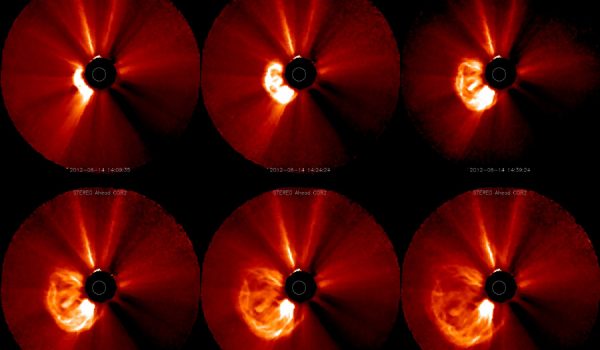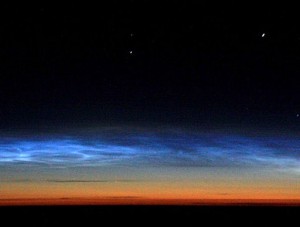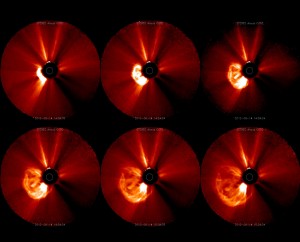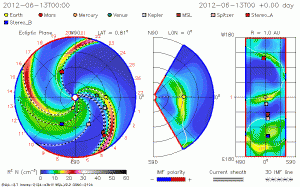
As the lead up to the 2013 solar maximum continues, another Sunspot cluster has shot two coronal mass ejections (CME) straight for Earth. Both CMEs should reach Earth on June 16. A similar cluster was responsible for two weeks of flares in March.
The first flare occured on June 13 when Sunspot AR1504 produced an M1 class flare – a mid-level flare not likely to do serious damage to electrical or space assets. The same spot released a second M1 class flare on June 15. Although Earth is mostly protected by its magnetosphere, both Venus and Mars are expected to lose some of their unprotected atmospheres to the duo.
The region of the Sun around AR1504 has developed a magnetic field particularly prone to releasing high energy solar flares. The US National Oceanic and Atmospheric Admionistration (NOAA) predicts a 65% chance of more medium class flares and a 5% chance of X-class, the most energetic flares, from that region over the next day.
The flares were caught at a lucky angle by NASA’s STEREO A solar observation satellite. STEREO A is one of a pair of satellites view the Sun simultaneously from opposing orbits. This allows them to capture 3D views of the Sun and see the “back” side of the Sun never visible from Earth. This time, STEREO A was looking at the coronosphere from the side with respect to the solar flares, capturing head-on views of their CMEs.
Although not the most severe class of flare, the simultaneous impact of the two CMEs will likely result in some level of geomagnetic storm and, at minimum, provide good aurora viewing over the next few days.

Noctilucent clouds photographed over Canada on June 13, 2012 (Credits: Brian Whittaker/Spaceweather.com).
Auroras won’t be the only thing to watch, though. According to Spaceweather.com, now is prime noctilucent cloud viewing time: “Data from NASA’s AIM spacecraft show that noctilucent clouds (NLCs) are like a great ‘geophysical light bulb.’ They turn on every year in late spring, reaching almost full intensity over a period of no more than 5 to 10 days.” According to the website, the bulb is now glowing. Clouds were spotted in Canada between Ottawa and Newfoundland on June 13. Historically, NLCs are best seen at high lattitudes in the western sky about 30-60 minutes after sunset. The origin of these bright blue clouds is not known.
Below, the Solar Dynamic Observatory caught a string of flares from Sunspot AR1504 in June:



















































































































![A trajectory analysis that used a computational fluid dynamics approach to determine the likely position and velocity histories of the foam (Credits: NASA Ref [1] p61).](http://www.spacesafetymagazine.com/wp-content/uploads/2014/05/fluid-dynamics-trajectory-analysis-50x50.jpg)



Leave a Reply